Returning to normalcy is exciting and refreshing for some. However, for those that struggle with anxiety and other mental illnesses, this return to normalcy can be overwhelming to say the least. For our children that may already struggle with anxiety, emotional regulation, and changes in routine, the return to this next school year may be that much more challenging than years in the past. For this reason, I am writing this article and providing a few tips for parents with such children, so as to start the process of preparing for school earlier.
The first recommendation I have as a clinical counsellor is to implement small, safe, forms of exposure over the remainder of the summer, including spending time around larger groups of family members or friends (as is safe and within parameters of COVID protocols). The reasoning behind this is that for over a year we have all grown used to small gatherings with plenty of space and minimal interactions. This is changing daily, and it can be overwhelming for anyone.
Connected to this, encourage your child to think of a “safe person” they can have at school, such as a best friend whom they can go to if any anxiety or strong, overwhelming feelings arise within the transition back to school. In any environment, it can be helpful to have a go-to friend to be by our side as a support.
Secondly, if your child is switching schools or going into high school, etc., walk around the school and ensure to get a tour of the school (if you have not already). This will help with your child becoming more comfortable and at ease in the new environment they are entering into. Ask for you and your child to get connected to teachers and counsellors at the school as soon as possible.
Lastly, practice simple skills with your child which challenge unhelpful thinking styles including catastrophizing, over-generalizing, etc. Below I have provided a list some of the most common unhelpful thinking styles, which all of us struggle with at least occasionally in life. Work with your child at countering unhelpful versus helpful thoughts over the latter half of the summer break. You can talk these through with your child, or if they prefer, they can write down their thoughts (with an example provided below).
Common Unhelpful Thinking Styles:
- Over-Generalizing – drawing a conclusion based on minimal evidence.
- All or Nothing – otherwise known as Black and white thinking
- Disqualifying the Positive – paying attention primarily to the negative
- Catastrophizing – blowing things out of proportion and making them into the worst case scenario
- Jumping to Conclusions – imagining we know exactly what others are thinking about us, or coming to conclusions as to what will happen in the future
- Shoulding & Musting – Using words such as should, must, have to, and being hyper-critical on ourselves
- Labeling – Sticking labels on ourselves such as “stupid,” “loser”, “lazy,” “worthless.”
- Personalization – blaming everything on ourselves; perpetually saying “I’m sorry.”
| Situation | Unhelpful Thought | Helpful Thought |
| Teacher asked me a question I didn’t know the answer to. | I am stupid, a failure, labeling. | It’s the first week back at school. I don’t need to know the answers to every question. |
In summary, it is vital to consider the numerous ways different children may be impacted by the transition into a new school year, and new stage in life in general. Think of each child as a different species of flower. Some flowers survive and grow no matter the environment, such as dandelions, while some such as orchids require very particular environments in order to thrive. It does not make that specific species of flower less beautiful or valuable, it simply means we need to cater to their individual needs, as is true for each uniquely vibrant child.
Joy & Wellbeing,
Megan Beyer

